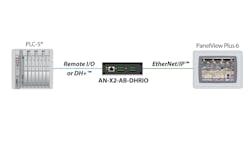Upgrading automation systems in manufacturing and processing facilities has always been a difficult task. But with the recent flurry of upgrades across manufacturing sectors—and more expected to come as a result of heightened interest in the cloud, Big Data, and the Internet of Things—it appears that ongoing upgrades will become more commonplace over the next several years.
Given that rip-and-replace is likely not an option, how do you go about integrating new machines and devices into your network when you’re likely already dealing with a plethora of different protocols?
To get more insight on this, I spoke with Danetta Bramhall of ProSoft Technology, a company that focuses on automation system communications.
“What you need is a plan that will allow you to layer new data communications technology over the top of what you already have,” Bramhall says. “Then you can gradually migrate your existing equipment and devices into your network, providing you with the ability to collect new kinds of data that could help increase your profit margin.”
Bramhall says the best way to start this layered—or phased—migration is by first deciding and prioritizing what data you really need to collect or measure for the specific operation you're looking to upgrade. Once you have this list you can begin planning out what you’ll need. “There are numerous protocol gateways on the market today that will allow you to quickly and cost-effectively integrate a new machine into your network or collect data from a legacy device,” she says. “These gateways act as translators from one protocol to another. They are relatively easy to install and, once up and running, allow your controller to talk to devices that speak a different protocol as seamlessly as if they were all on one network.”
To clarify her point, Bramhall provides an example of a hydro-electric power facility adding new generators to a network that uses IEC-104 or DNP3 protocols and Modbus controllers. Once the new generators are installed and you’re looking to track alarms and collect data from them, this is where adding a stand-alone or in-chassis gateway can give you the real-time data from those new generators over your existing network.
The same goes for a manufacturing plant that’s installing new packaging equipment. “Just because you’ve got a new packaging system doesn't mean you’re going to replace all of your legacy bar code scanners,” says Bramhall. “By using a protocol interface gateway, you can leave those existing bar code scanners where they are for now and use the gateway to connect your old and new equipment.”
Referencing one of ProSoft Technology’s own products as an example of such a gateway, Bramhall makes mentions of the EtherNet/IP to Remote I/O or DH+ gateway. “This gateway allows users to take a phased-migration approach when migrating to EtherNet/IP-based control systems,” she says, “because it allows for EtherNet/IP updates of Remote I/O and DH+-based drives, PanelViews and Flex I/O adapters. Users are able to upgrade their system with minimal scheduled downtime and no PLC code changes.”
In addition to strategically planning your phased migration with the use of a protocol gateway, one other thing you have to do is “stop adding any more custom, proprietary systems that make it hard or impossible to get data out of them,” Bramhall says. “Start small and add interface connectivity gateways where it makes the most sense now, and then keep adding as your budget allows.”

